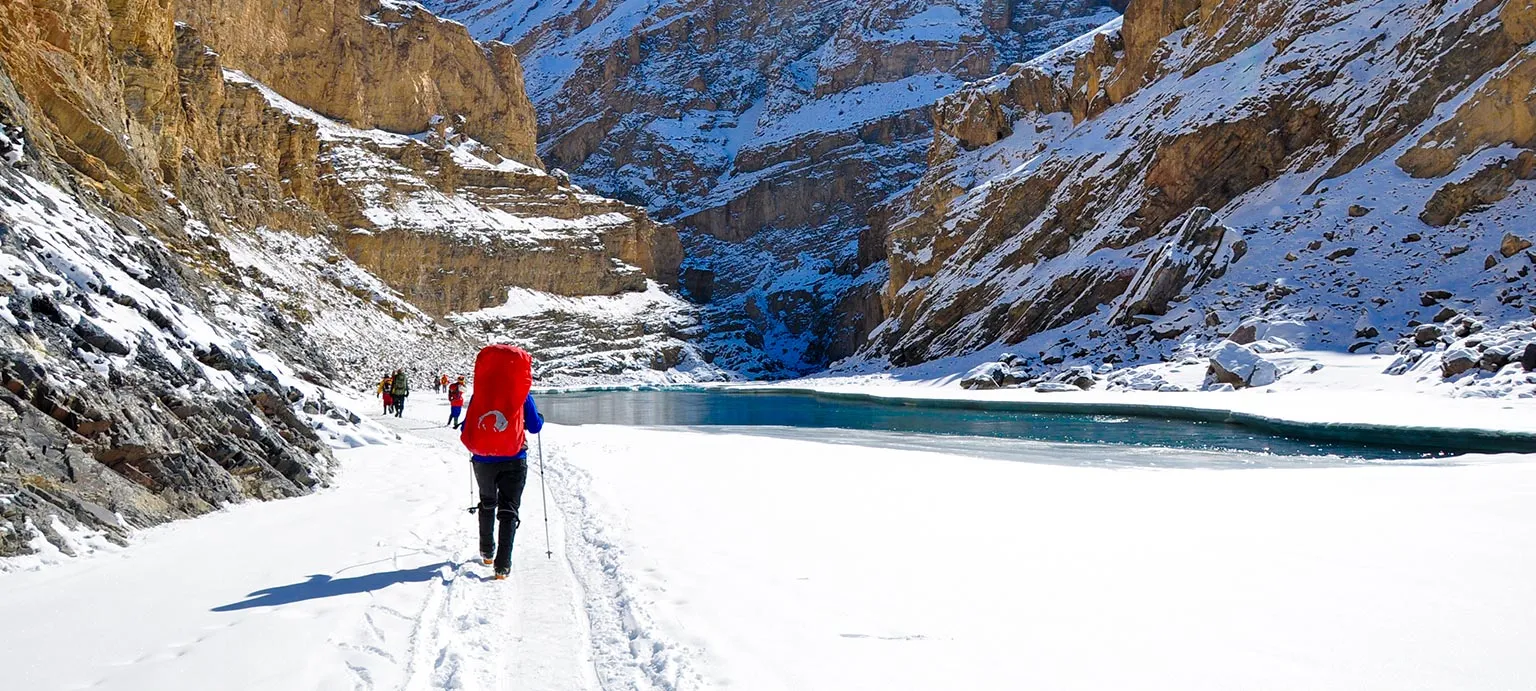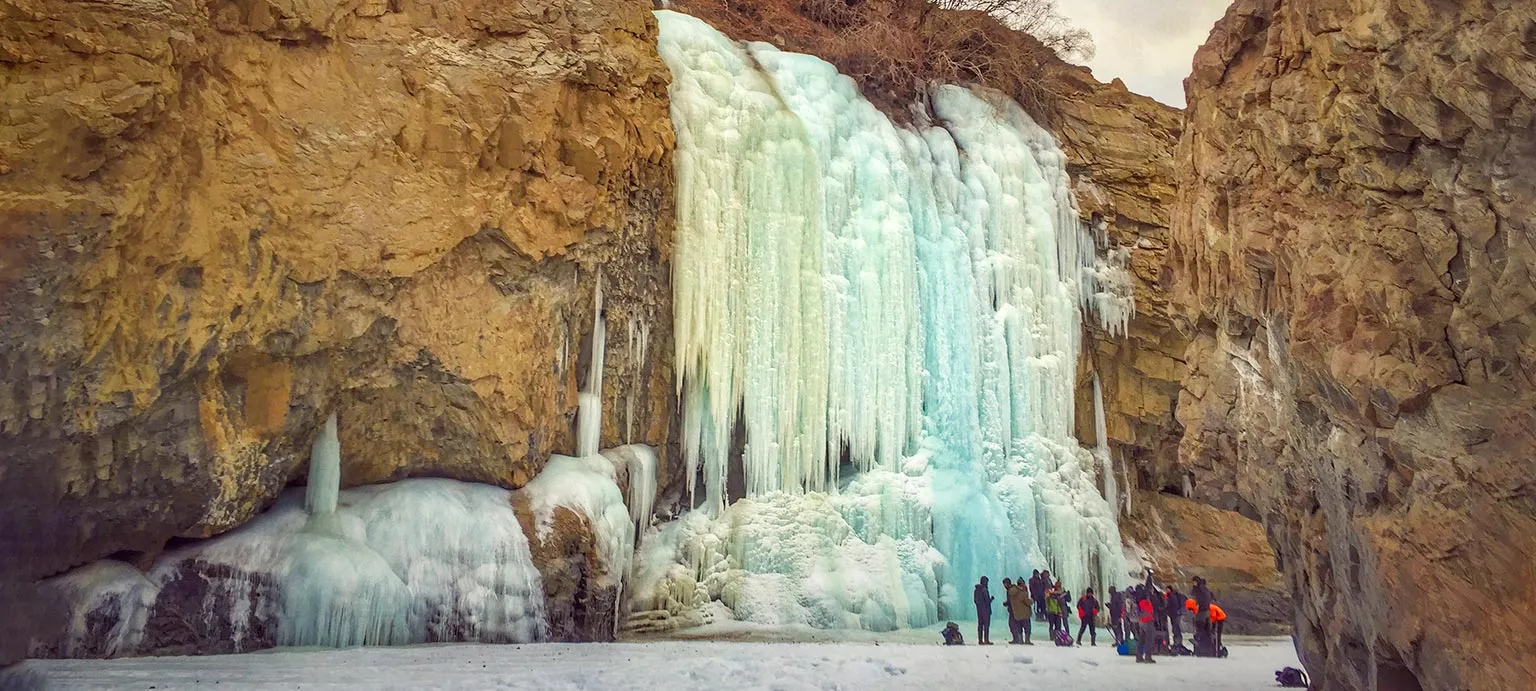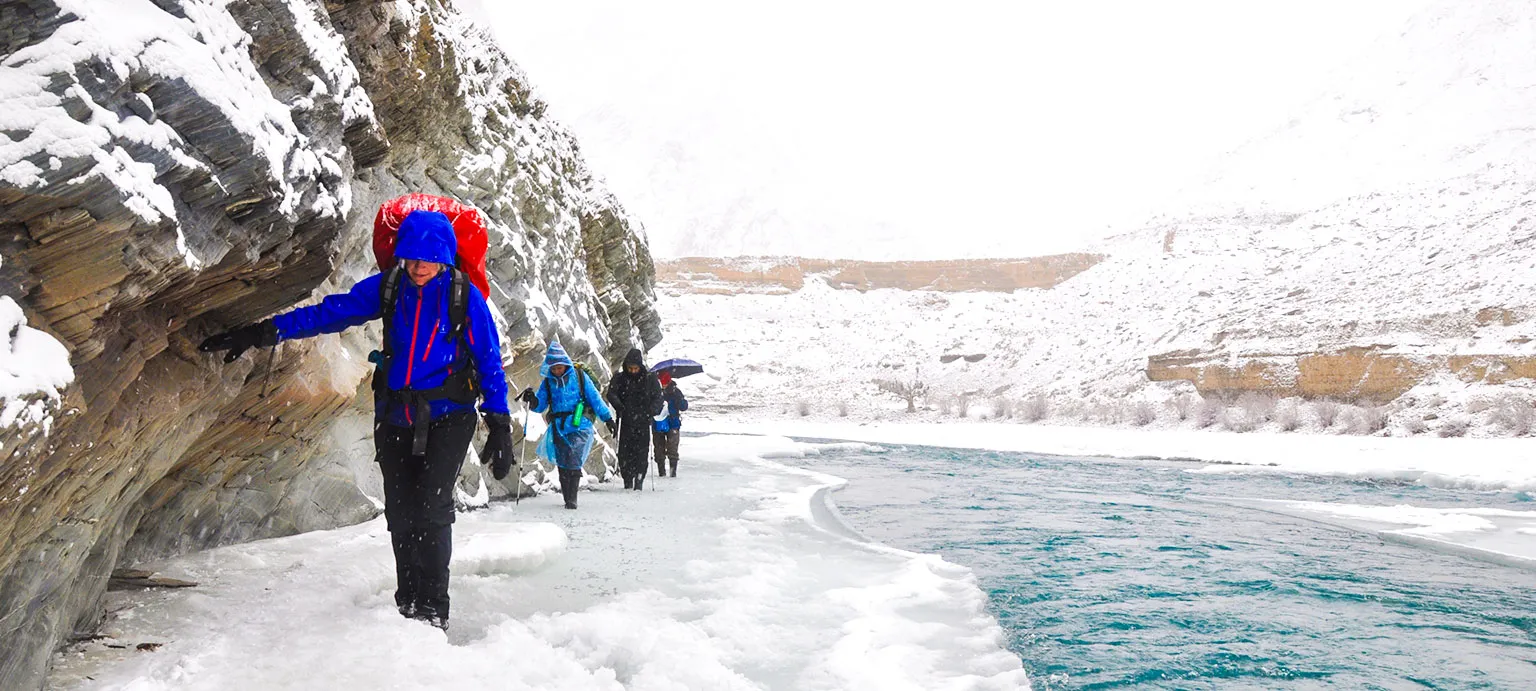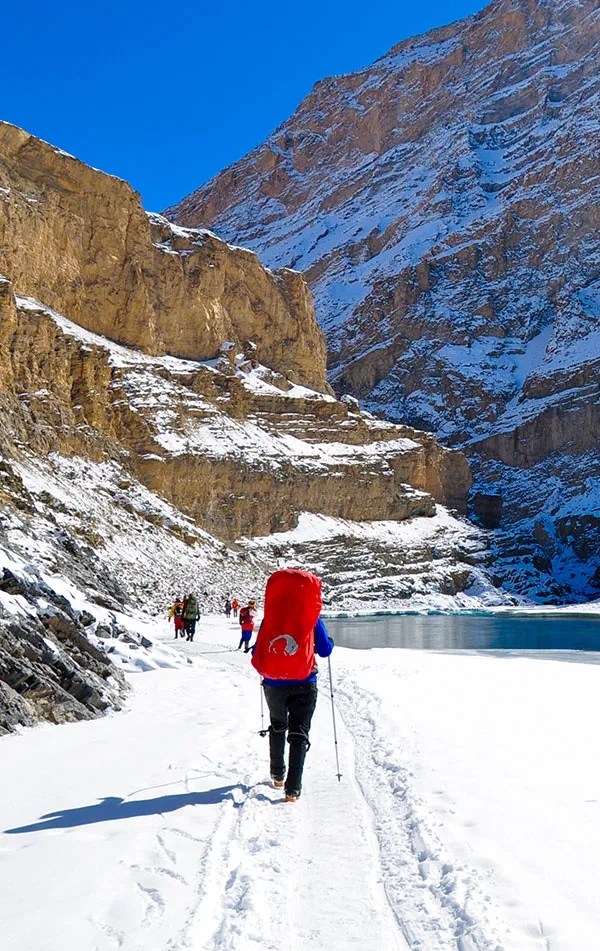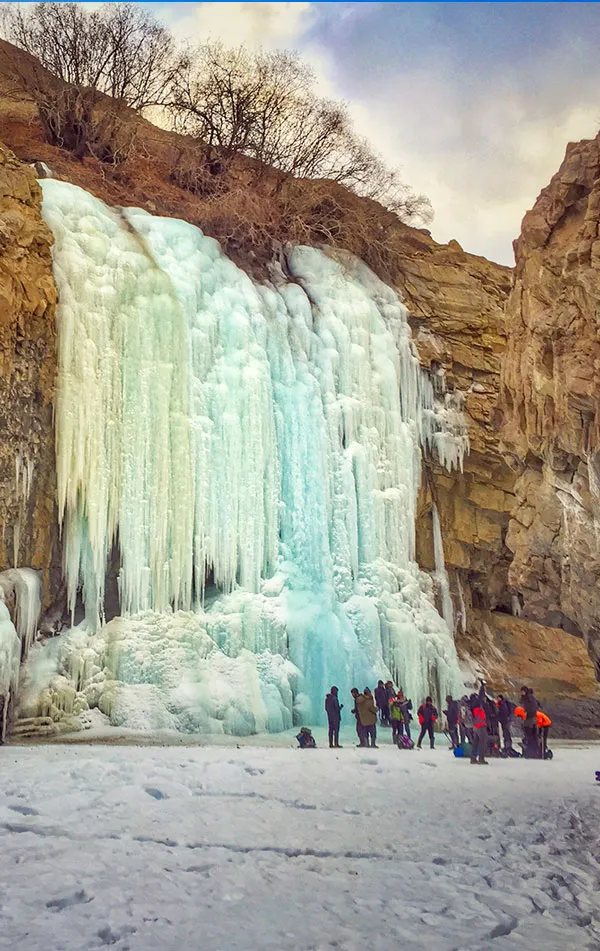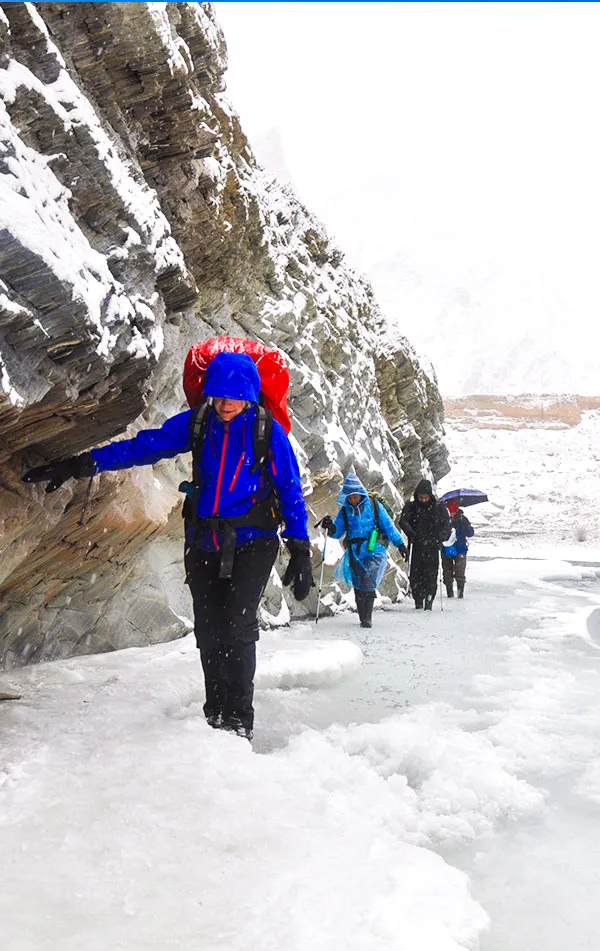
Region
Ladakh | India
Duration
8 Days
Max Altitude
11100 Ft.
Trekking Km
62 KM
Grade
Difficult
Help & Support
10:00 hrs to 18:00 hrs | GMT +5:30
Monday - Saturday | Sunday Closed
26500 /Person
- +5% GST (goods and services tax)
- Services Leh to Leh
- Addons
For more information. Please complete this form.
Help & Support
+91 991 772 4737info@trekthehimalayas.com 10:00 hrs to 18:00 hrs | GMT +5:30
Monday - Saturday | Sunday Closed
Overview
Trek Name: Chadar Trek Frozen River
Days: 8
Adventure Type: Trekking
Base Camp: Leh
Season:Winter |
Month:January | December |
Country: India
Altitude: 11100 Ft.
Grade: Difficult
Rail Head: -
Stay: Hotel & Camping
Food: Meals while on trek
Location: Ladakh
Distance: 62 Km.
Trail Type: Point to point trail | Camping at the same location upon returning.
AirPort: Leh (Kushok Bakula Rimpochee)
Highlights:
- +5% GST (goods and services tax)
- Services Leh to Leh
Why Chadar Frozen Trek is a Must-Do:
- The Chadar Frozen Trek is renowned as one of the world's most iconic and challenging treks, offering a unique and extraordinary experience for adventurers.
- Takes trekkers through the starkly beautiful and remote landscapes of Ladakh, providing an opportunity to witness the untouched beauty of the region.
- Trekkers traverse the frozen Zanskar River, experiencing the thrill of walking on a solid ice sheet, transforming the river into a surreal frozen wonderland.
- Trekkers face extreme winter temperatures, with the mercury often plummeting well below freezing, reaching as low as -30°C (-22°F) during the night. This challenging environment adds an element of resilience to the trek.
- Provides an incredible cultural experience as trekkers pass through the remote villages and interact with the local communities along the frozen river.
- Highlights the awe-inspiring Nerak Waterfall, a significant milestone on the trek. The frozen cascade of ice is formed due to the chilling temperatures, creating a mesmerizing natural wonder.
- Features the Tibb Cave, a naturally formed overhang along the frozen river cliffs. This cave serves as a crucial shelter for trekkers, offering respite from the biting cold, wind, and a place to rest, warm up, and prepare meals.
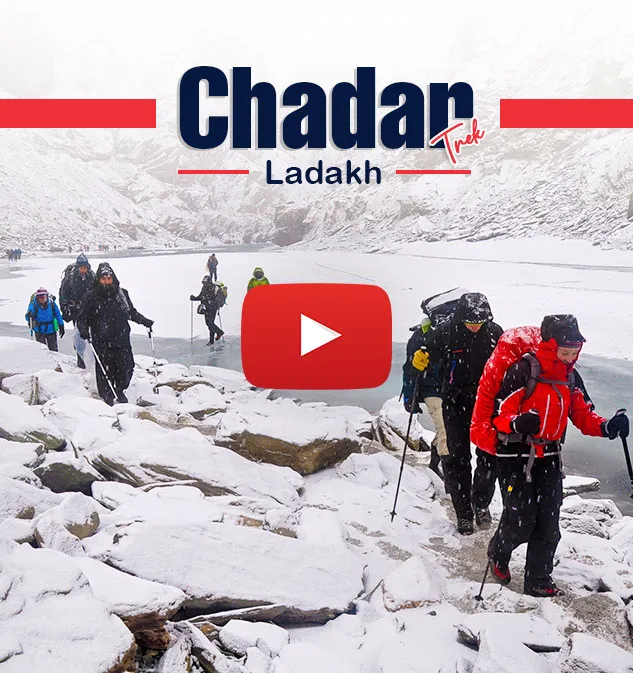
Who Can Participate
-
Age; 12 years +.
-
First timers can apply; previous trekking experience is more appreciated.
-
The climber must be fit and have sufficient stamina to cover 5 km of distance in 30 minutes without stress.
-
The climber should be able to carry a 10-15 kg backpack.
-
Pulse rate at rest must be in between (60 to 90 beats per minute)
-
Blood Pressure Reading must be in between (DIASTOLIC 70 – 90, SYSTOLIC 100 - 140 mm Hg)
-
Respiratory rate at rest must be in between (12 to 20 breaths per minute)
-
Should not have Liver and kidney issues
-
Should not have Diabetes Mellitus, Bronchial Asthma, Heart problems, Hypertension etc
-
No pacemaker implant
-
People with the Sinus issues, Epilepsy please contact to trek coordinator before booking the trek
-
If your BMI is not normal, Please contact our Trek coordinator before Trek booking.
Medical & Disclaimer Form (Mandatory Documents) Click here to download Medical & Disclaimer Form
- Government Employees can avail the benefit of Special Casual Leave (SCL) when you join us for a trekking expedition. As per the rules of the Pay Commission, Special Casual Leave can be availed for up to 30 days in a calendar year for trekking/mountaineering expeditions through a registered organization. Trek The Himalayas is a registered adventure tour operator by Indian Mountaineering Foundation (IMF) and Ministry Of Tourism (MOT)
- Trekkers have to apply for leave at least 20 days before trek departure date,
- This service is exclusive to Indian government employees and is applicable only for treks within India.
- Do mail at info@trekthehimalayas to apply and mention your booked trek date and trek name.
- Junior trekkers (below 15 years) should have a company of parents/guardians.
- Trekkers between 15 to 18 years can come solo with the disclaimer form signed by parent/guardian.
- Medical & Disclaimer Form (Mandatory Documents) Click here to download Medical & Disclaimer Form
Itinerary
Reporting day at Leh
- Altitude: Leh 3,500m/11,450 ft.
- Keep your woolen cap and gloves handy at Airport.
- Airport pickup is not included in the cost.
- Orientation & Briefing of the trek at 12:00 noon (Mandatory).
- Check in Hotel (10:00 am | centrally heated room |attached washroom in running condition | hot water in buckets.
- Bring a copy of your ID proof and 2 photographs. Foreigner, a copy of passport and visa.
- Keep the boarding pass with you, it will be needed for permission on the third day.
- The network is available (only post-paid).
- ATM is available.
- Visiting any very high-altitude place or pass is not advisable.
- Consumption of alcohol and smoking is strictly prohibited.
- Spend the day in the room itself to acclimatize.
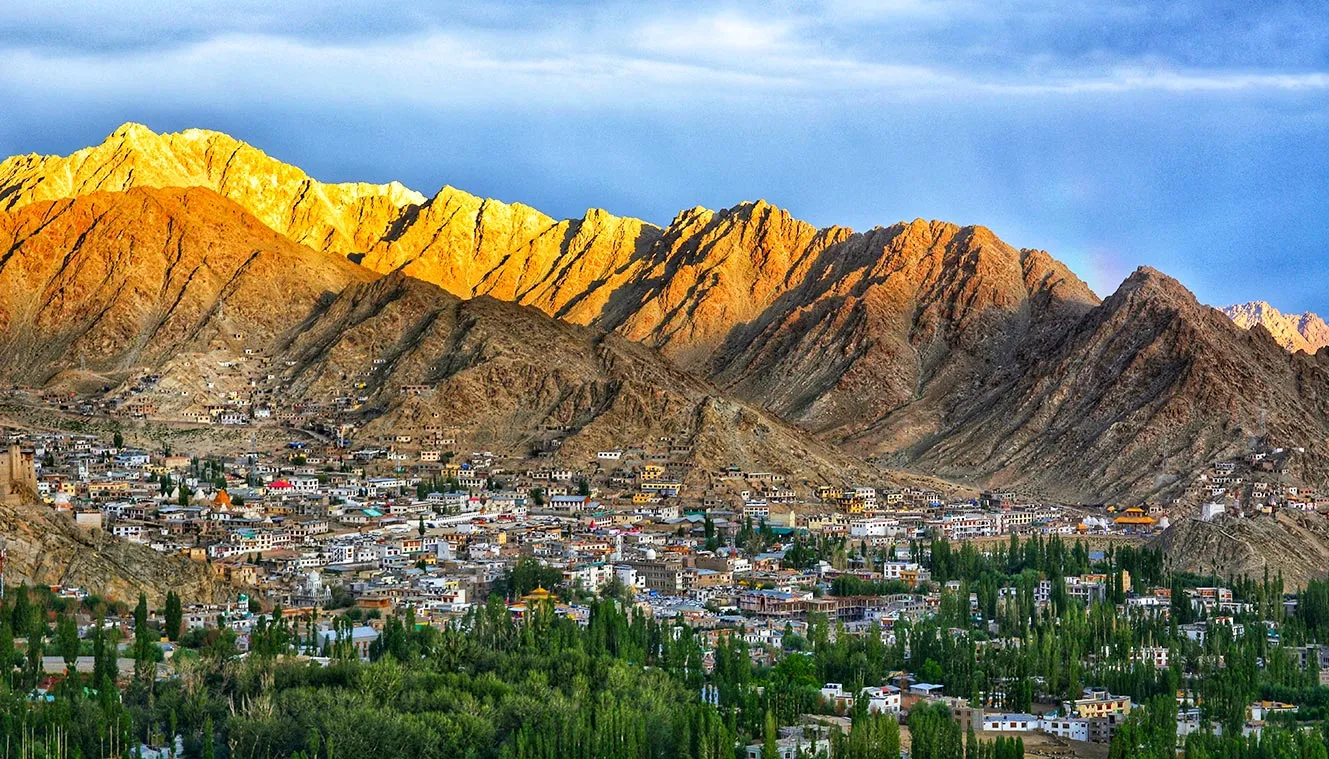
You will be landing at the Leh airport which is one of the most picturesque airports that you would come across. Just before touchdown time, you'll be greeted with the entire range of snow-capped peaks that will surely get you wonderstruck. It's important to keep your warmies handy as you'll feel the sudden drop in temperature as soon as you arrive at the Leh airport. A jacket, woollen gloves and a woollen cap is a necessity. After reaching the guesthouse you will be given enough time to relax and acclimatize to the conditions. Later in the evening, you can spend some time at the Leh market for last minute window shopping. It is very important that you get used to the cold temperature in Leh because the temperature will only tend to fall as you start walking on the frozen Zanskar. From the end of January to mid-February, the temperature can be anything between -10 to -15 degrees during the day. It is also important to keep your body hydrated by increasing the intake of fluids that will help to maintain your body temperature.
Acclimatization Day
- Rest + Acclimatisation day.
- Sightseeing included in the cost (Hall of Fame, Shey Monastery, Thiksey Monastery).
- Visit of any very high altitude place or pass is not advisable.
- Consumption of alcohol and smoking is strictly prohibited.
- Stay in Hotel | centrally heated room |attached wash room in running condition | hot water in buckets.
Keeping in mind the health problems that trekkers are facing (AMS), as per the new regulations applied, anyone doing the Chadar Trek should be atleast spending two days in Leh to get your body fully acclimatize to the weather conditions. It is irrevocable and it is important that it is strictly followed by every trekker. You can spend the day by visiting the places around the city. You can also join us while we conduct a small sight seeing session(included in the cost). It is only for 3-4 hours, covering all the major spots of Leh. It is advisable that you avoid visiting places which are at a higher altitude. Crosscheck your essentials before going to bed.
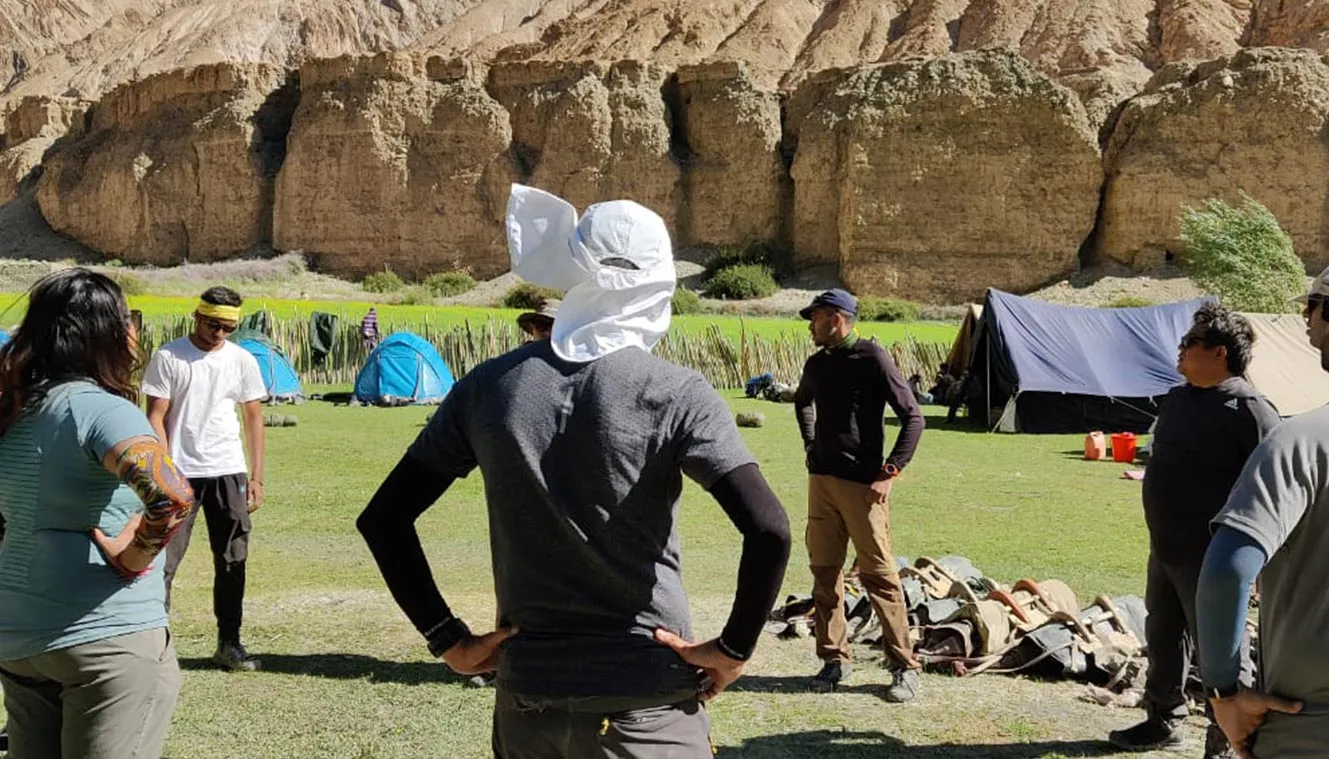
Medical test day
- Wake up early and get ready for medical tests | height & weight, blood pressure and oxygen level.
- Drive/Walk to the Government Medical camp.
- Get your Oxygen and BP reading (There is a long queue due to rush of tourists. It may take 3-4 hours depending on the rush).
- Late afternoon insurance formalities.
- Enjoy evening in Leh.
- Stay in Hotel | centrally heated room |attached wash room in running condition | hot water in buckets.
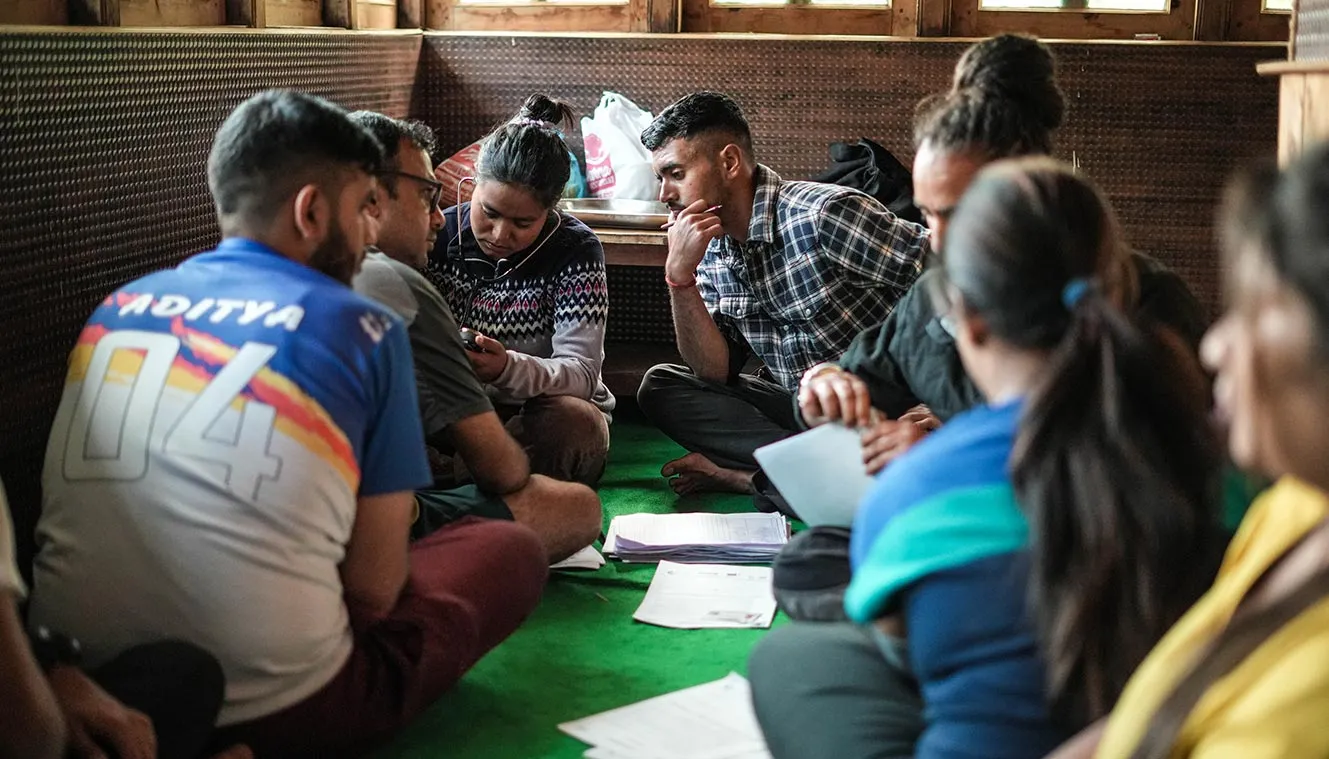
Today is the big day. This day decides whether you continue further or not. Wake up early and reach the Medical Camp as early as possible. Even though tests take less time, due to tourist rush it gets delayed. In the late afternoon we shall finish insurance formalities, if any. In case the tests declare you are not fit go for Chadar trek, you will not be allowed. For refund policies, please contact your Trek Coordinator.
Leh to Shingra Koma drive & Trek to Tsomo Paldar
- Altitude: Tsomo Paldar 3,200m/10,500 ft.
- Altitude: Shingra Koma 3,150m/10,300
- Breakfast at hotel included in the cost.
- Drive: Shingra Koma 75 km, 3-4 hrs.
- Trek: 3km | 2 hr.
- Gumboots are mandatory.
- Carry two thermos flask of 1 litre each.
- Hot lunch on the way.
- Stay in tents | twin sharing.
- Drive through Gurudwara Pathar Sahib (3,500m/11,500ft), Magnetic Hill (3,350m/11,000ft) and the confluence of the Zanskar and Indus (3,100m/10,200ft).
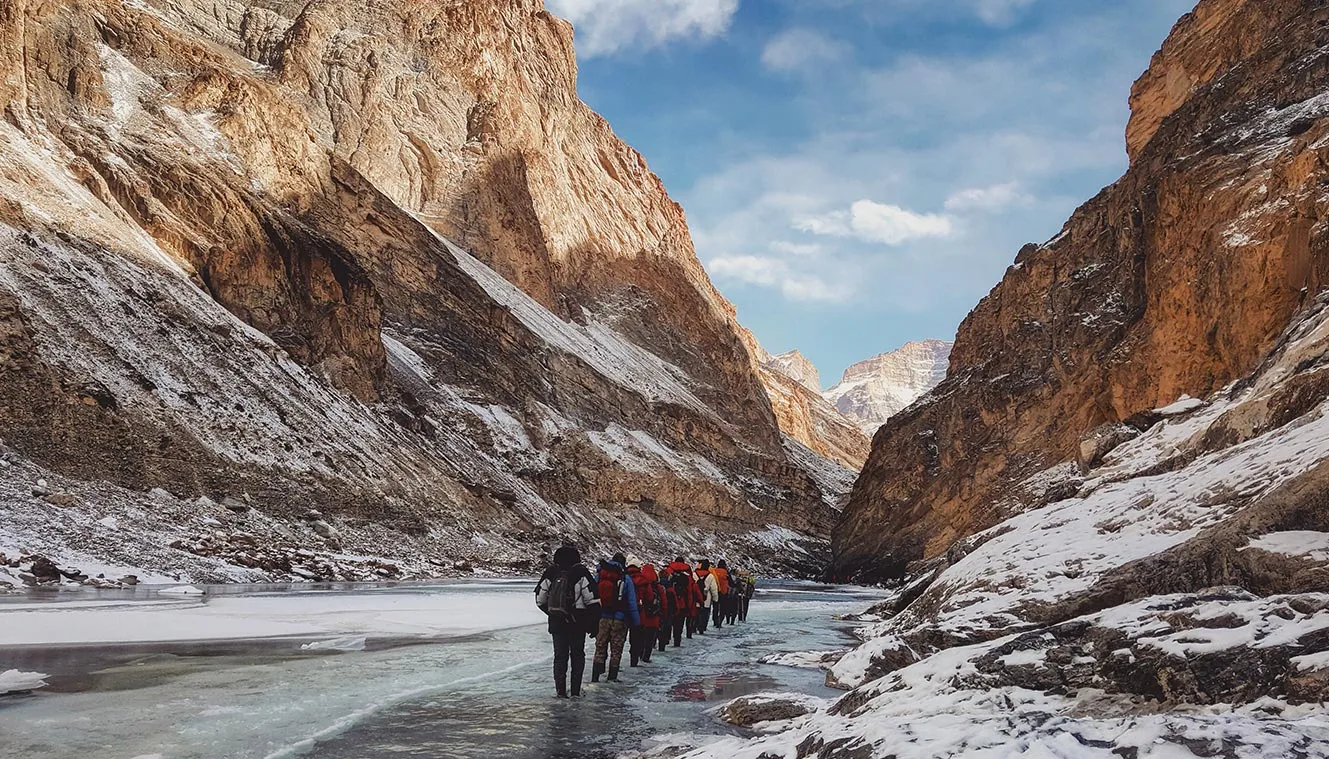
Note: Walking in gumboots will take a while, so be prepared for some slips and falls! It’s advisable to carry a small backpack which will protect your back at the time of falls.
On this day, you'll be headed to the first campsite which is Tsomo Paldar via Chilling & Shingra Koma. Shingra Koma is the most unique place of Chadar for it is placed at U bend of Zanskar. Forming a wonderful place with lots of views. Today will be one of the most scenic drives which lets you witness some of the top spots in Ladakh. Gurudwara Pathar Sahib, Magnetic Hill and the confluence of the Zanskar and Indus are some of the places where you can take a pit stop for clicking pictures. After 3-4 hours drive along the Zanskar will get you to Shingra Koma. The car will drop you right where the road ends, this will be your starting point of walking on the Zanskar.
The layer of Chadar may seem thin here, but you can also see various rock formations. Walking with gumboots on will definitely be a challenge in the initial stage. Understanding the ice patterns will take time, slowly but steadily you will know which surface is fragile and which is trustworthy. There are multiple ice surfaces that you would come across while walking on the mighty Zanskar and as you start walking you will know more about it. Planting your foot will be important in most cases, you can check for the ice for its steadiness with your walking stick before stepping on it wholeheartedly. A small and light backpack will help as you will able to manage your body weight in an effective manner. After an hour and a half of slipping, falling and trying to gather your balance you'll be reaching your first campsite at Tsomo Paldar. This will be your first experience of camping under sub-zero temperatures.
Tsomo Paldar to Tibb Cave
- Altitude: 3,350m/ 10,950 ft.
- Trek 14km | 6-7hr.
- Make sure you fill your thermos with warm water before you leave.
- Pass through a waterfall which never freeze.
- It will be sunny only around 9-10 in the morning.
- Hot Lunch on the way.
- Visit small cave, in that cave the local porters rest for the night.
- Stay in tents | twin sharing.
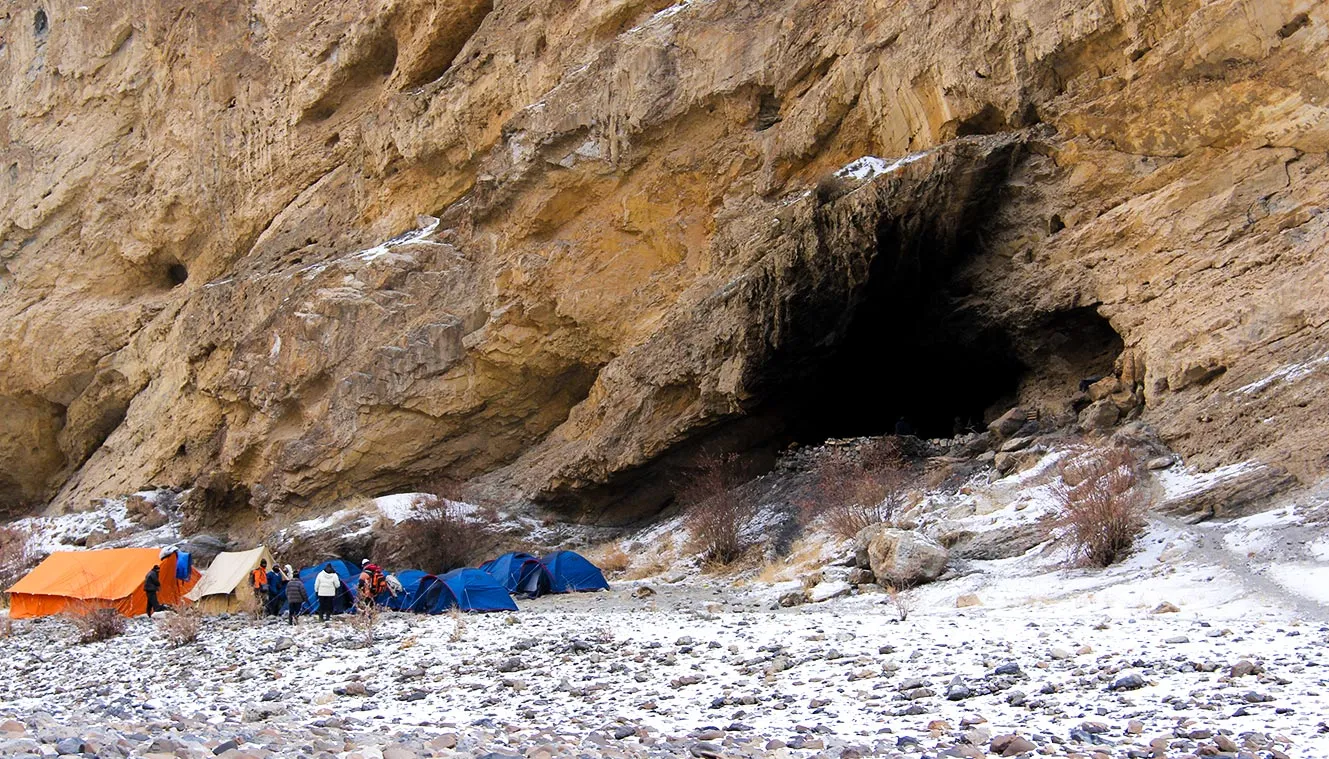
Chadar is one such trek where your not gaining altitude in quick successions. Slowly but gradually from Tsomo Paldar to Tibb Cave (6-7 hours), you will be gaining an altitude of 400ft. (Tsomo Paldar: 11,400 to Tibb Cave: 11,800) After spending a cold night in the tent at Tsomo Paldar get done with you breakfast that will re-energize your senses in the morning. The much needed hot cup of tea will be special in such frosty conditions. As you start heading to the next campsite which is Tibb Cave, this trek route has some of the most eye-catching frozen waterfalls that youll see. Waterfalls that stand frozen in time. The source of some of these frozen waterfalls is still unknown and there are a lot of myths amongst the villagers. The mighty Zanskar will be flowing all along with you on the trail and the emerald green water will have a smooth soothing You will be served lunch midway to Tibb cave. After walking for a couple of hours youll come across different rock patterns along the way which look art looks when the sun rays fall on them making their way from behind the clouds. You will be camping near the Tibb cave which is surrounded by dry sand.
Tibb Cave to Nerak
- Altitude: 3,400m/11,100 ft.
- Trek 13 km / 6-7 hrs.
- Attraction Frozen waterfall.
- Hot Lunch on the way.
- Make sure you fill your thermos with warm water before you leave.
- Nerak is the first village of Zanskar region.
- If we reach Nerak Camp on time, we can go to Nerak village.
- Stay in tent.
As you move on to the most awaited campsite of the trek which is Nerak, the 13km long trail will take you to the most iconic landmark of the Chadar trek. i.e. The frozen waterfall. The frozen waterfall is a natures masterpiece that attracts trekkers around the world. Hot lunch will be served on your way to Nerak. By far, Nerak will be the coldest of all the campsites on the trek where the temperature goes down to as low as -30 degrees during the night. It will be important that you wear proper clothing in layers to stay safe from the biting cold. If you manage to reach the waterfall on time, there are chances of paying a visit to the Nerak Village as well. You will be camping at a distance of 15-20 minutes from the waterfall.
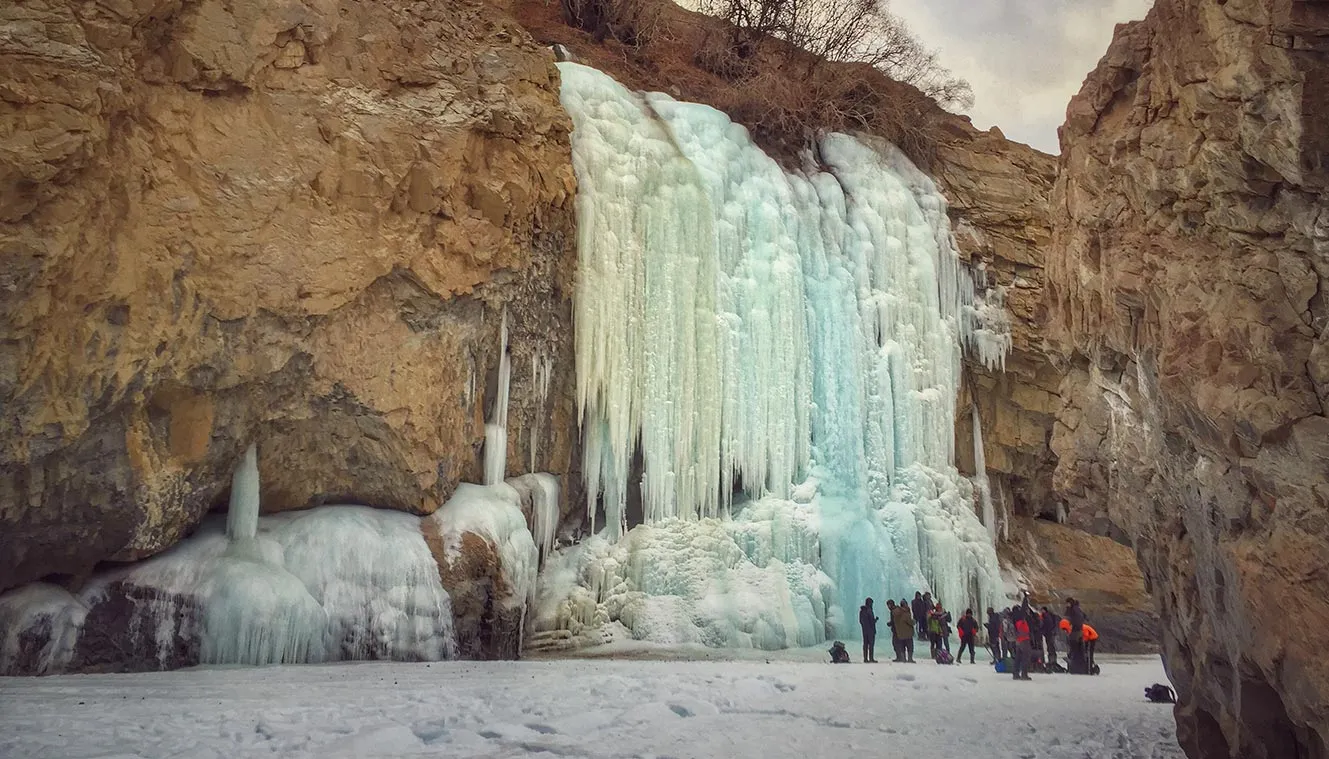
Nerak – Tibb Cave
- Altitude 3,400m/11,100 ft to 3,350m/10,950 ft
- Trek 13 km / 5-6 hrs.
- Hot Lunch on the way.
- Make sure you fill your thermos with warm water before you leave.
- Stay in tent.
You might have heard stories of how unpredictable the weather patterns can get here on the Chadar trek. There are instances where the formation of Chadar no longer exists on your way back from Nerak. In the same way, you will witness a new layer of Chadar formed at some. Even though its the same route, youll be amazed to see how different it appears while coming back. Chadar Trek is an experience of a lifetime that every trekking enthusiast should witness. And then, what if we told you that these eight days of your life are going to be some of the best days youve lived so far and that youll cherish these moments till the very end.
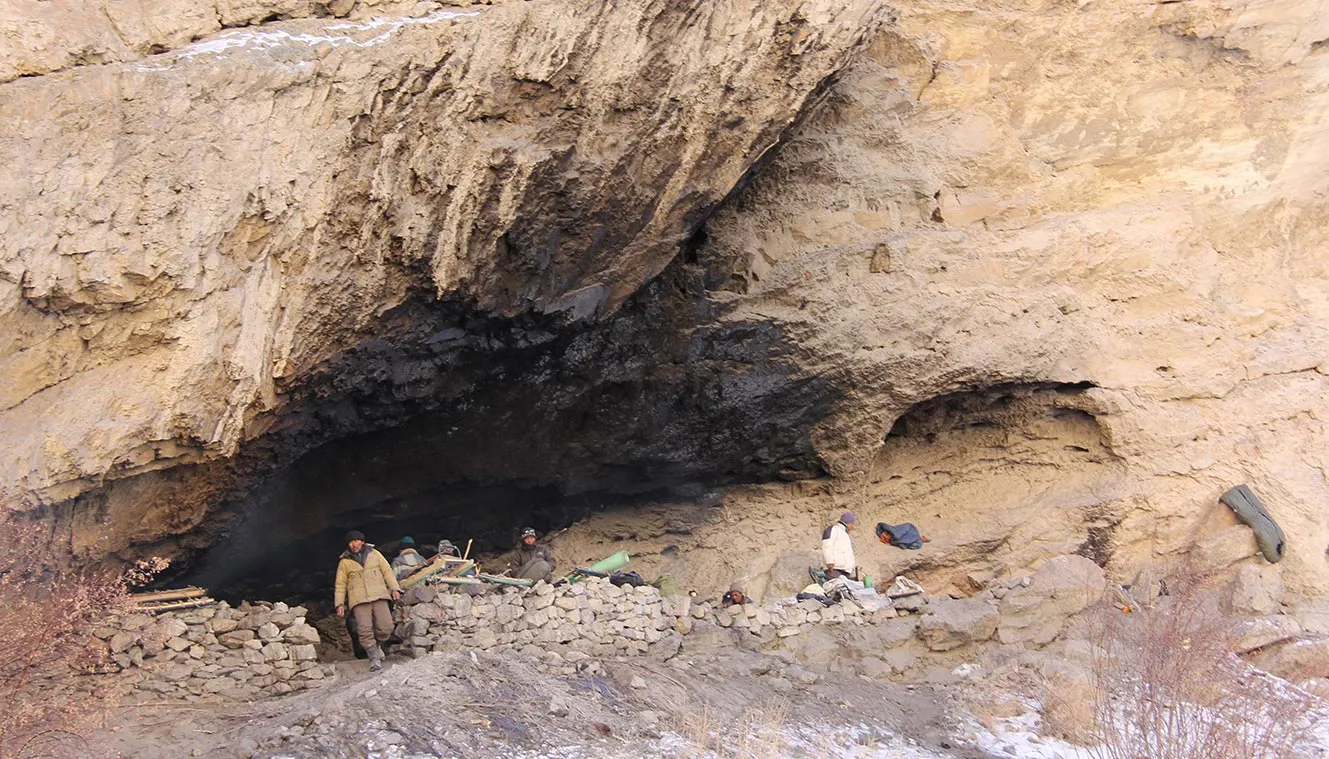
Today retrace your steps back to Tibb Cave. You get another last chance to cherish, relive and gather the memories. Wave goodbye to all the locals while you make your way back. Be careful and enjoy your last stay in tents.
Tibb Cave to Shingra Koma then Drive to Leh
- Altitude 3,350m/10,950ft to 3,150m/10,300 ft.
- Trek to Shingra Koma 17 km/ 5-6 hours.
- Drive to Leh 70 km/ 3-4 hours.
- Hot Lunch on the way.
- Make sure you fill your thermos with warm water before you leave.
- You will reach Leh by the evening.
- Stay in hotel (Centrally heated room) (Running hot water in taps).
Again wake up early for a long walk back. It is not really retracing steps because you may observe a lot have changed. Chadar may have melted, layer of Chadar may have gotten thin, wonderful rocks are visible now. Wea ll, thats the beauty of nature and Chadar trek. Reach Shingra Koma and get ready to board on vehicles. Another bumpy ride and you will arrive in Leh.
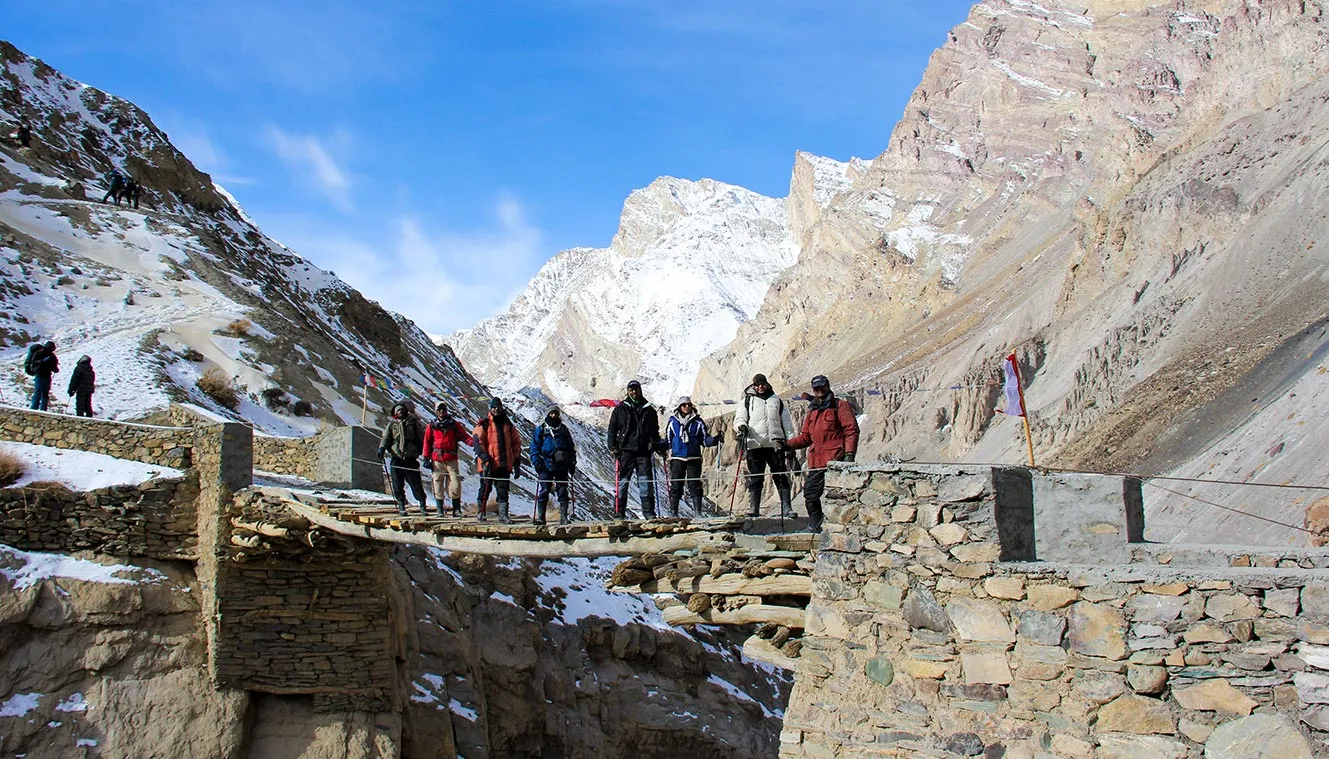
Note:
- Keep 1or2 buffer day in your travel plan
- If buffer day is not used in the travel then it can be used to Explore Leh.
- Distance, Altitude, and Trekking hours are approximate and rounded off.
- Keep the original and copy of ID proof handy
- Come one day early if planning to come by plane.
Day-1: Reporting day at Leh
- Altitude: Leh 3,500m/11,450 ft.
- Keep your woolen cap and gloves handy at Airport.
Day-2: Acclimatization Day
- Rest + Acclimatisation day.
Day-3: Medical test day
- Wake up early and get ready for medical tests.
Day-4: Leh to Shingra Koma drive & Trek to Tsomo Paldar
- Altitude: Tsomo Paldar 3,200m/10,500 ft.
- Drive: Shingra Koma 75 km, 3-4 hrs.
- Trek: 3km | 2 hr.
Day-5: Tsomo Paldar to Tibb Cave
- Altitude: 3,350m/ 10,950 ft.
- Trek 14km | 6-7hr.
Day-6: Tibb Cave to Nerak
- Altitude: 3,400m/11,100 ft.
- Trek 13 km / 6-7 hrs.
Day-7: Nerak – Tibb Cave
- Altitude 3,400m/11,100 ft to 3,350m/10,950 ft
- Trek 13 km / 5-6 hrs.
Day-8: Tibb Cave to Shingra Koma then Drive to Leh
- Trek to Shingra Koma 17 km/ 5-6 hours.
- Drive to Leh 70 km/ 3-4 hours.
Note:
- Keep 1or2 buffer day in your travel plan
- If buffer day is not used in the travel then it can be used to Explore Leh.
- Distance, Altitude, and Trekking hours are approximate and rounded off.
- Keep the original and copy of ID proof handy
- Come one day early if planning to come by plane.
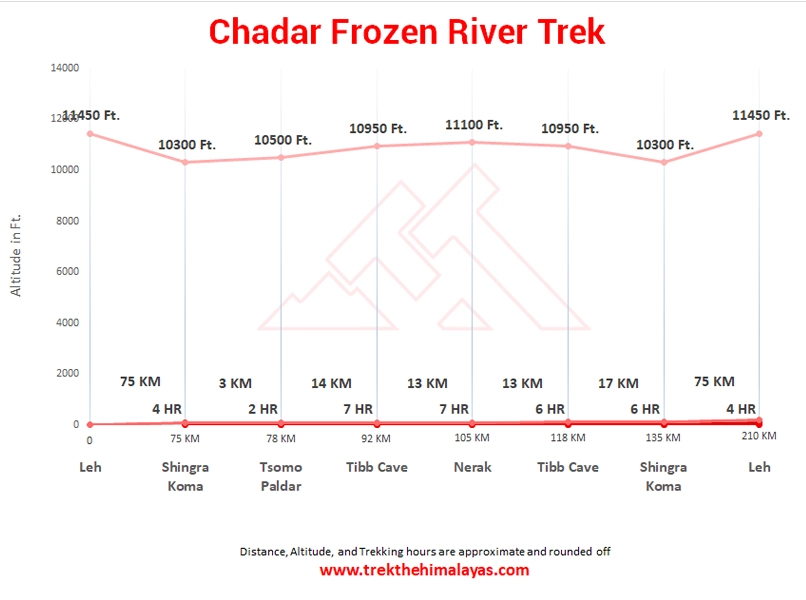
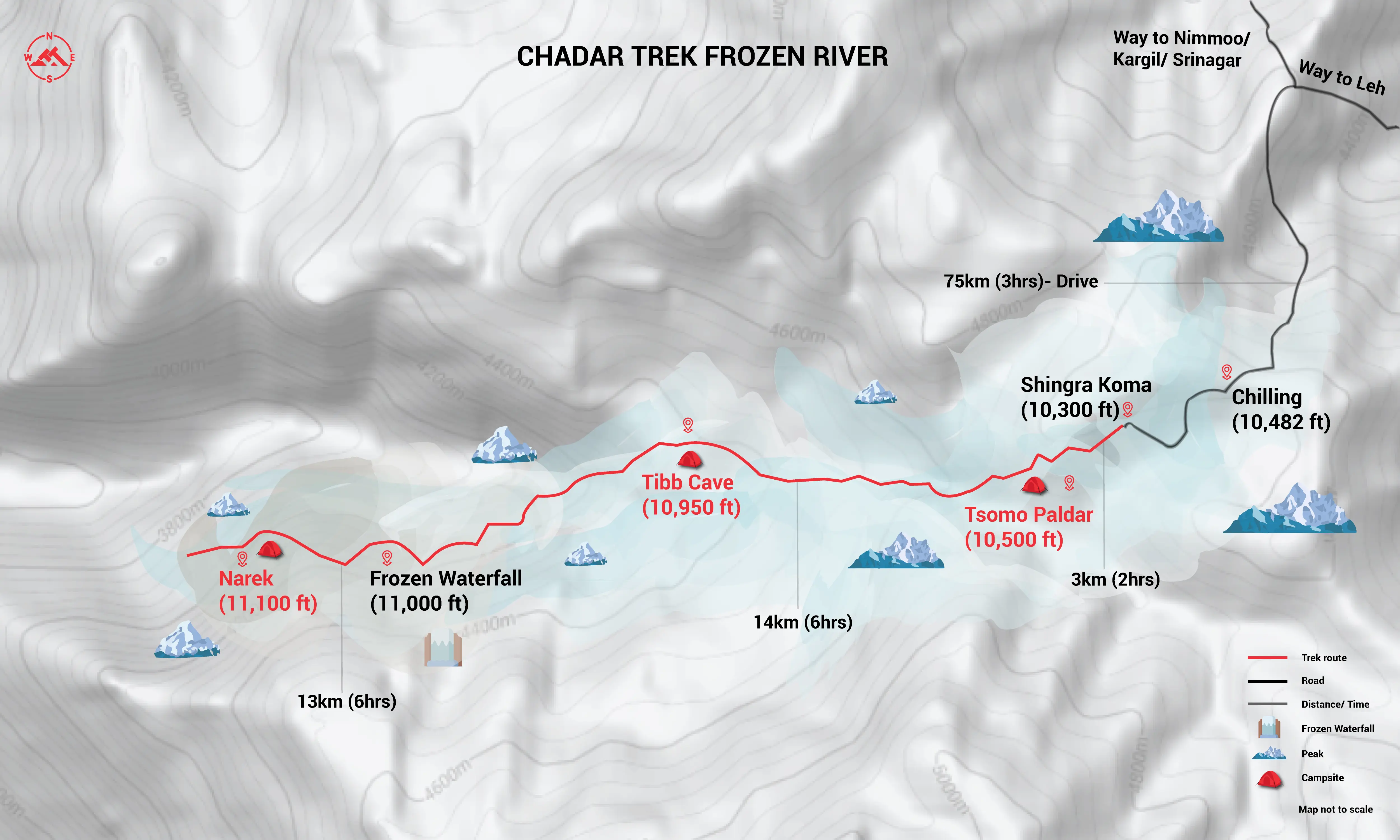

Important Links
Medical & Disclaimer Form (Mandatory Documents) Click Here.
How To Reach
It is essential for everyone to arrive at Leh (01:00 pm)
The only way to travel is to fly to Kushok Bakula Rimpochi Airport located in Leh. It is just 4 km away from the main city. The airport is well connected to Delhi and also receives flights from Mumbai, Srinagar, Jammu, Chandigarh and other general destinations in India. Even international travellers can fly directly from major cities like Kolkata, Mumbai and Delhi.
It's quite convenient to secure a cab from outside the airport to reach our hotel. Alternatively, you can inform your coordinator to arrange a cab for you. Upon booking the trek, your trek coordinator will furnish you with the hotel details.
Travelling by both the road routes, the Manali-Leh Highway and Srinagar-Leh Highway, is not possible since they are not open in the snowy winters of Ladakh.
The Manali-Leh and Srinagar-Leh highways are generally closed by October-November
For your return journey from Leh, you have to choose only air transport options. Please ensure an early check-out in the morning, as all flights operate during the morning hours.
.webp)
Cost Terms
Inclusion
1. Accommodation (as per the itinerary):
- Guest house (centrally heated room)(attached washroom) in Leh on Day 1, Day 2, Day 3 & Day 8 (twin sharing basis, triple in very rare cases)..
- Camping during the trek (Day 2 to Day 6).
2. Meals (Veg + Egg):
- All meals while on trek. .
- Day 4 breakfast to day 8 lunch.
3. Support:
- 1 Versatile base camp manager: handles communication and deploys extra manpower in emergencies.
- 1 Mountaineering & First aid qualified professional expedition Leader.
- 1 Experienced high altitude chef.
- Local experienced guides (Number of guides depending on the group size).
- Enough support staff.
4. Trek equipment:
- Sleeping bag, Sleeping liners (if required), Mattress, Utensils.
- 3 men all season trekker tent (twin sharing), Kitchen & Dining tent, Toilet tent.
- Camping stool, Walkie talkie.
- Ropes, Helmet, Ice axe, Harness, Gaiters & Crampon (if required).
5. First aid:
- Medical kit, Stretcher, Oxygen cylinder, Blood pressure monitor, Oximeter, Stethoscope.
6. Transportation (as per the itinerary):
- Leh (Guest house) to trekking point (Day 4).
- Trekking point to Leh (guest house) (Day 8).
7. Clock room service at Leh.
8. Mules/porters to carry the central luggage.
9. All necessary permits and entry fees, Upto the amount charged for Indian.
10. Services from Leh to Leh.
Exclusion
1. Food in Leh.
2. Insurance (Mandatory).
3. Any kind of personal expenses.
4. Pickup and drop from Leh airport.
5. Mule or porter to carry personal luggage.
6. Emergency evacuation, hospitalization charge or etc.
7. Anything not specifically mentioned under the head Inclusion.
8. Any additional cost due to the final decision incurred by the Administrative.
9. Pre Medical Check-up and Rescue fee, Wildlife/environmental charges, ALTOA NOC, and entry fees upto 6K to 8 K paid to the authority on the spot.
Things can be provided on demand and availability (participant has to pay extra for these things).
1- Gamow/PAC HAPO Bag (Portable Hyperbaric Bag) - is a unique, portable hyperbaric chamber for the treatment of acute mountain sickness (AMS), also known as altitude sickness.
2- AEDs (Automated External Defibrillators) - are portable life-saving devices designed to treat people experiencing sudden cardiac arrest, a medical condition in which the heart stops beating suddenly and unexpectedly.
Cancellation terms:
Cancellations prior to 25 days from the start of the Trip
Refund options
- 5% deduction of trek fee
- 100% cash voucher for any trip till one year
- Transfer your trek (any trek, any date) to your friend
Cancellation between 24 days and 15 days to the start of the Trip
Refund options
- 30% deduction of trek fee
- 100% cash voucher for same trip till one year
- 85% cash voucher for any trip till one year
- Transfer your trek (same trek, any date) to your friend
Cancellation between 14 days and 10 days to the start of the Trip
Refund options
- 50% deduction of trek fee
- 80% cash voucher for same trip till one year
- 70% cash voucher for any trip till one year
- Book the same trek, in the same season, with any other batch
- Transfer your trek (same trek, any date) to your friend
Cancellation less than 9 days to the start of the trek
Refund options
- No cash refund
- 20% cash voucher for the same trip till one year
- 10% cash voucher for any trip till one year
- Transfer your trek (same trek, same date) to your friend
Note- If a booking is made using a voucher or discount code, the policies related to vouchers and discounts cannot be modified.
In the unlikely event that TTH cancels a trek prior to the scheduled departure date:
While it is extremely rare for TTH to cancel a trek, we understand that unforeseen circumstances or natural disasters may occasionally require us to do so before the scheduled departure. These circumstances could include continuous rain or snow, thunderstorms, snowstorms, landslides, floods, earthquakes, or any other natural calamity that poses a risk to the safety of our trekkers. Additionally, unforeseeable events such as local riots, curfews, pandemics, lockdowns, government orders, or any similar situations that compromise the safety of the trekking experience may also necessitate a cancellation.
In the event of such a cancellation, TTH will provide you with a voucher equivalent to the amount you paid for the trek. This voucher can be redeemed for any of our treks within the next year, allowing you to still enjoy an adventure with us at a later date.
Note
-
The issuance of a voucher is not applicable in situations where you are required to descend from the trek for any reason. The trek leader may make the decision to send you down from the trek due to factors such as insufficient fitness level, symptoms of Acute Mountain Sickness (AMS), high blood pressure, exceeding the designated turn-around-time, health concerns, or if you are found smoking, drinking, or violating the rules set for the trek. In such cases, the provision of a voucher does not apply.
In the rare event that TTH shifts a trek:
We would like to emphasize that weather conditions in high-altitude areas are highly unpredictable and can undergo sudden changes at any time, irrespective of the day. Additionally, circumstances beyond our control, such as natural disasters, political unrest, pandemics, and lockdowns, may impact the feasibility of conducting a trek. In cases where we are unable to proceed with an event due to such circumstances that are beyond our direct control, we will make every effort to provide you with an alternative trek that is safer and more suitable.
In such situations, we will issue a voucher to offset the cost difference between the originally scheduled trek and the alternative trek. This voucher can be redeemed at any time within one year from the date of issue. Please note that a refund fee or reimbursement of the cost difference is not applicable in these cases.
Note:
- Change of trek batch is dependent on the availability of seats in the batch
- In case of transferring a trek to a friend, he/she should satisfy all the mandatory requirements put forward by TTH
- TTH holds the right to change/cancel the policies, without prior notice
- Cash refund is applicable only in case of bookings made without using any promotional offer code or vouchers
Cash Voucher Terms:
- This is a non-transferable voucher
- The voucher cannot be merged with any other offer of Trek The Himalayas
- The voucher is valid for Trek booked directly with Trek The Himalayas in India
- To avail the voucher please use your register phone number or e-mail id
- All the other Terms of booking a trek with Trek The Himalayas are applicable to the voucher
- Trek The Himalayas holds rights to add/remove any of the Terms and Conditions without prior notice
Itineraries are based on information available at the time of planning and are subject to change. "Trek The Himalayas" reserves the right to change expedition dates, people or itineraries as conditions warrant. If a trip must be delayed or the itinerary changed due to bad weather, road conditions, transportation delays, government intervention, airline schedules, sickness, or other contingency for which TTH or its agents cannot make provision, the cost of delays and/or other changes are the responsibility of the participant. TTH reserves the right to decline, or accept, any individual as a trip member for any reason whatsoever.
Trek Essentials
PDF Of Trek Essential Download
| Backpack with rain cover | (50 - 60 ltr) with comfortable shoulder straps |
| Day pack with rain cover | 20 - 30 ltr (If off-load opted) |
| Walking stick | Advisable (At least one) |
| Water Bottle / Hydration pack | 2 thermos flask bottles of one liter each, Don't bring hydration pack. |
| Small size tiffin/lunch box | 1 Nos |
| Snacks | Energy bars, dry fruits, electoral/ors |
| Personal Medical Kit | Consult your doctor |
| T-Shirt (Synthetic quick dry) | 1 Half sleeves |
| Fleece T-shirt | 2 Nos |
| Wind stopper / Fleece jacket | 1 Nos |
| Windproof Jacket | Not required |
| Down feather / Hollow jacket | 1 Nos |
| Thermal inner (Upper and Lower) | 1 Pair |
| Trek Pant (Synthetic quick dry) | Not required |
| Wind stopper / Fleece Pant | 2 Nos. |
| Waterproof gloves | 1 Pair |
| Fleece / woollen gloves | 1 Pair |
| Poncho / waterproof Jacket and pant | 1 Nos |
| Sunscreen | 1 Nos. |
| Moisturiser | 1 Nos. |
| Chap-stick / Lip balm | 1 Nos. |
| Toothbrush and toothpaste | 1 Nos. |
| Toilet paper & Wipes | 1 Nos. |
| Hand sanitizers | 1 Nos. |
| Antibacterial powder | 1 Nos. |
| Quick dry towel | 1 Nos. |
| Head torch | 1 Nos. (Avoid Hand torch) |
| Sun Cap | Not required |
| Woolen cap | 1 Nos. |
| Balaclava | 1 Nos. |
| Buff / Neck-gaiters | 2 Woollen |
| Sunglasses | UV with dark side cover, People who wear spectacles - (A)- Avoid contact lenses | (B)- Photo chromatic glasses |
| Trekking shoes | 1 Pair (Gumboots) |
| Floaters / flip-flops | Not required |
| Cotton socks | 3 pairs |
| Woollen socks | 4 pairs |
| Gaiters | Not required |
| Micro spikes | Not Allowed |
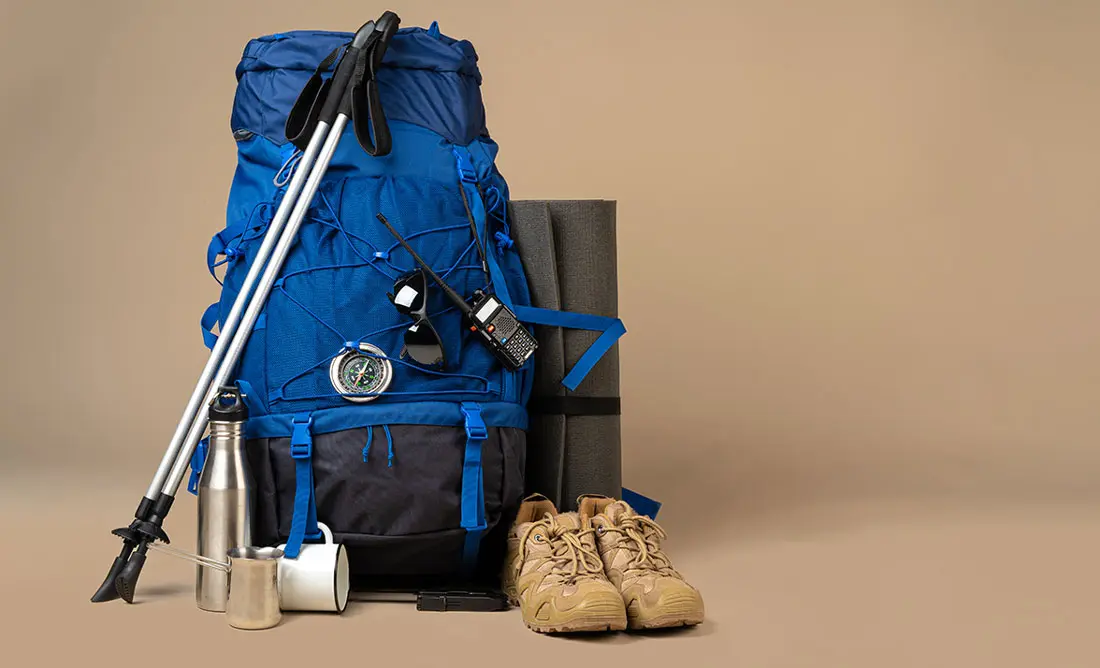
Frequently Asked Questions(FAQ)
To register with TTH, visit our website - www.trekthehimalayas.com and create your account. To create your account you will need to use your email address and fill in all the details, set your unique password and your account is ready to use.
- To book a trek with TTH, you first need to register with us and create an account.
- Choose the trek that you want to do and click on available dates.
- You will land at the login page, fill in the required details.
- Add Participants, choose add-on services click on the Pay now button, choose your preferred payment method, and make the payment. TTH accepts multiple payment options, including credit/debit cards, net banking, and UPI.
- You will receive a confirmation email from TTH with all the necessary details about the trek, including the meeting point, transportation, accommodation, and other important instructions.
please send an email to us at info@trekthehimalayas.com or reach out to the numbers provided in the Help and Support section of your Trek Page. We will ensure that your issue is promptly resolved.
To book services such as off-load luggage and transportation, you can find them listed as add-ons. These additional services can be booked at the time of your initial booking. If you miss booking add-ons during the initial reservation, you can log in anytime and easily book 4 days before the departure date add-ons through the platform.
In such a situation, please log in to your account and transfer your trek or date to the desired one within 12 hours or drop us an email at info@trekthehimalayas.com 10 days before the departure date of the trek. After the initial 12-hour period, any changes will be processed according to the cancellation policy.
We recommend visiting our "Suggest Me a Trek" page. By filling out the form, our experts will contact you with the best possible trek options based on your preferences and experience level. Alternatively, you can reach out to us via email at info@trekthehimalayas.com or give us a call using the numbers provided on our website for personalized assistance and recommendations.
Family treks differ from regular treks by focusing on ease of difficulty, offering shorter durations for younger participants, Kid-friendly and easily digestible foods, child-friendly activities, maintaining a higher guide ratio for diverse age groups, and implementing additional safety measures for families.
Family Trek with Kids recommendation Only Dayara Bugyal and Chopta Chandrashila Trek.
Minimum age for TTH treks is typically 7 years, though this may vary depending on the specific trek.
Yes, you can take a kids to a high-altitude trek with a parent. Discuss with a trek expert before booking a trek.
Junior trekkers (below 15 years) should have a company of parents/guardians.
Trekkers between 15 to 18 years can come solo with the disclaimer form signed by parent/guardian.
Medical & Disclaimer Form (Mandatory Documents) Click here to download medical and disclaimer form
Physical Fitness: Ensure your child is physically fit. Engage them in regular exercise, outdoor activities, and hikes to build stamina and endurance. Hydration: Emphasize the importance of staying hydrated at high altitudes. Encourage your child to drink water regularly, even if they don't feel thirsty. Proper Nutrition: Provide a well-balanced diet with sufficient carbohydrates for energy and foods rich in iron to prevent altitude sickness. Adequate Sleep: Ensure your child gets enough sleep in the days leading up to the trek. Quality rest is crucial for altitude adaptation. Educate on Altitude Sickness: Teach your child about the symptoms of altitude sickness, such as headache, nausea, and dizziness. Encourage them to communicate any discomfort immediately. Appropriate Clothing and Gear: Dress your child in layers to adjust to changing temperatures. Ensure they have appropriate trekking gear, including sturdy footwear. Positive Mindset: Foster a positive mindset. Encourage your child, and let them know it's okay to take breaks when needed. Medical Check-Up: Schedule a medical check-up before the trek to ensure your child is fit for high-altitude activities. Consult with a healthcare professional about any potential health concerns.
TTH takes special care to provide wholesome and nutritious food for children on treks. Here are some of the foods that are typically served for children:
Breakfast: For breakfast, TTH serves a variety of options like porridge, cornflakes, bread, butter, jam, honey, boiled eggs, omelettes, and pancakes. Children can choose from these options to fuel themselves for the day's trek.
Lunch: For lunch, TTH serves lunch which includes rotis, vegetables, rice, dal, and salad. The rotis are usually made fresh on the trek and are a good source of carbohydrates. The dal and vegetables provide protein and other essential nutrients.
Snacks: TTH provides healthy snacks like fresh fruits, dry fruits, energy bars, cookies, and biscuits to keep the children energized throughout the day.
Dinner: For dinner, TTH serves a hot and wholesome meal which includes soup, rice, dal, vegetables, and a non-vegetarian dish (if requested in advance). Children can also choose from a variety of desserts like custard, jelly, and fruit salad.
Dietary requirements: If a child has any special dietary requirements, TTH can cater to those needs as well. For example, if a child is lactose intolerant or allergic to nuts, the kitchen staff can make arrangements to accommodate those requirements.
Choosing the right trek for a beginner can be a bit overwhelming as there are many factors to consider such as distance, elevation gain, terrain difficulty, weather, and time of year. Here are some tips that can help you choose the right trek for a beginner:
1. Determine fitness level: Assess the fitness level of the beginner to understand their physical capabilities. This will help you select a trek that is challenging but not too difficult.
2. Choose a well-traveled trail: A well-traveled trail will have more amenities such as signposts, water stations, and shelter. It is also safer as there will be other hikers on the trail.
3. Consider the length of the trek: For beginners, it is recommended to start with a shorter trek that can be completed in a day or two. This will help them get acclimatized to trekking and build their confidence.
4. Look for gradual elevation gain: Choose a trek with a gradual elevation gain rather than steep ascents. This will make the trek easier and more enjoyable.
5. Check the weather: Check the weather forecast before selecting a trek. Avoid treks during the monsoon season or winter when the trails can be slippery or dangerous.
6. Research the trail: Read about the trail to get an idea of the terrain, altitude, and difficulty level. This will help you select a trek that is suitable for the beginner.
7. Consult with an expert: If you are unsure about which trek to choose, consult our trek expert Mr. Nitin (+91 70600 59773) between 10 AM to 6 PM (Tuesday - Friday). Mr. Nitin will provide you valuable advice and guidance.
Overall, it is important to choose a trek that is enjoyable, challenging but not too difficult, and suitable for the beginner's fitness level and experience.
It is not recommended for a beginner to choose a difficult Himalayan trek. Trekking in the Himalayas can be physically and mentally challenging, especially if you are not used to the high altitude, steep slopes, and rugged terrain. Choosing a difficult trek without the proper experience, fitness level, and preparation can be dangerous and put you at risk of altitude sickness, injury, and other hazards.
If you are a beginner, it is recommended to start with an easier trek and gradually build up your skills and experience. This will help you understand the challenges of trekking in the Himalayas, and also prepare you physically and mentally for a more difficult trek in the future. It is also important to choose a trek that matches your fitness level, experience, and interest.
There is no specific age limit for a beginner trekker. However, it is important to consider your physical fitness, health condition, and personal interests before embarking on a trek. Trekking in the Himalayas can be physically and mentally demanding, and requires a certain level of physical fitness and endurance.
If you have any pre-existing medical conditions or are above a certain age, it is recommended to consult with a doctor before embarking on a trek. It is also important to listen to your body and take breaks as needed during the trek to prevent exhaustion or injury.
We recommend visiting our "Suggest Me a Trek" page. By filling out the form, our experts will contact you with the best possible trek options based on your preferences and experience level. Alternatively, you can reach out to us via email at info@trekthehimalayas.com or give us a call using the numbers provided on our website for personalized assistance and recommendations.
Yes, you can join the trek. We have fixed departure groups where you can simply book your trek and we will take care of curating a group.
Before you start the trek, it is recommended that you make all the necessary phone calls as during the trek you may or may not receive network coverage, once you come back to the Base Camp, you can reconnect with your family via phone once again. You can share your trek coordinator contact detail with your family members to get the latest updates about your trek batch.
At TTH, we provide wholesome and nutritious meals during the trek. The food is vegetarian and includes a variety of dishes such as rice, dal, vegetables, chapati, paratha, pasta, noodles, and soup. We also offer snacks such as biscuits, and salty, and dry fruits during the trek. Special dietary requirements such as vegan, gluten-free, or Jain food can also be arranged if informed in advance.
If you are allergic to some foods, you need to let us know in advance so that we can make arrangements accordingly.
TTH is a trekking company that prioritizes the safety of all its participants, including women trekkers. They have a comprehensive safety system in place, which includes a dedicated team of experienced and trained trek leaders and support staff who are equipped to handle emergency situations and provide first aid.
TTH also takes specific measures to ensure the safety and comfort of women trekkers. They have a separate tent accommodation for women trekkers, female trek leaders, and support staff. They also provide separate toilet facilities for women and encourage a safe and respectful environment for all trekkers.
Moreover, TTH has a strict policy against any kind of harassment and has a zero-tolerance policy towards such incidents. They have a designated Internal Complaints Committee (ICC) to investigate and address any complaints related to harassment or misconduct. Overall, TTH has a good reputation for safety and responsible trekking practices, and women can feel comfortable and safe while trekking with them.
In case you are the only women in the group, we provide a single sleeping arrangement. Also, during the trek, the trek leader will always remain by your side to provide optimum safety and reassurance.
You can reach out to the trek coordinator to inquire about the number of female trekkers and their respective states who have booked the trek. Please note that the trek coordinator cannot disclose personal details of any trekker. Once you've confirmed your booking, a WhatsApp Group will be created for all the trekkers in your batch. This allows you to connect with fellow trekkers before the trek begins.
While many of our treks are led by female trek leaders, however, it is not possible to know which trek leader is assigned to which group. But nonetheless, whether the trek leader is male or female you can be completely assured of your safety and security with us.
Yes, it is possible to trek with periods. However, it is important to take some extra precautions and preparations to ensure a comfortable and safe trekking experience.
Here are some tips that can help you trek during your period:
1. Use menstrual hygiene products that you are comfortable with, such as tampons, pads, or menstrual cups. It is recommended to carry enough supplies for the entire duration of the trek.
2. Pack wet wipes, hand sanitizer, and plastic bags to dispose of used hygiene products.
3. Wear comfortable and breathable clothing that allows for easy movement and reduces friction. Avoid wearing tight or restrictive clothing that can cause discomfort.
4. Carry pain relief medication, such as ibuprofen or acetaminophen, in case of menstrual cramps.
5. Stay hydrated and maintain a balanced diet to support your energy levels and overall health.
6. Take breaks as needed and listen to your body. If you feel uncomfortable or experience any unusual symptoms, seek medical attention immediately.
It is also recommended to consult with a doctor before going on a trek during your period, especially if you have a pre-existing medical condition or are taking medication. By taking necessary precautions and being prepared, you can have a safe and comfortable trekking experience even during your period.
We provide proper disposal facilities for sanitary pad disposal during the trek.
We offer three person tents with twin-sharing for optimum comfort. A woman trekker will share a tent with another woman trekker and if you are the only woman in the group, you will be given a single accommodation for your comfort and privacy.
Yes, we do provide gears on rent. You can book it using you TTH account directly.
Mountaineering qualified Experienced and first aid certified Trek Leader, First Aid Certify local guide, Cook, helpers and supporting staff.
People suffering from Bronchitis, Asthma, High blood pressure, Epilepsy (got faints), TB , Heart problem or on higher BMI side are strictly not allowed to go on any Himalayan trek. Apart from this if you had any medical history, please let us know.
No. Alcohol and smocking isn’t allowed while on trek. It is totally misconception that it will keep you warm. Your body need to acclimatize properly and for that eat properly and drink enough water; these things will keep you warm.
Toilet tents provide a convenient solution for answering nature's call in the great outdoors. Dry toilets, in particular, offer a highly sanitary approach. By digging a pit and utilizing mud and a shovel, you can easily cover up your waste. This method ensures cleanliness and hygiene while camping or exploring in the forest.
Remember to pack essential toiletries to complete your outdoor bathroom kit and maintain proper personal hygiene during your adventures. With these practices in place, you can enjoy nature while also respecting it.
Layer Up From Head To Toe
Eat Full Meals, never sleep empty stomach
You can keep warmee (if you’re more susceptible to cold).
Use sleeping bag in right way and don’t leave free space in sleeping bag.
For upper body
– Thermal layer
– T-shirt (full-sleeves)
– Fleece T-shirt (for extreme colds)
– Fleece layer
– Thick Jacket/Down Jacket
– Waterproof or Windproof layer (outermost layer, when it is snowing or raining)
- For Lower Body
– Thermal layer
– Hiking pants (normal) or Winter hiking pants
Based on how warm you feel you can skip any of the above layers. Your outer later should be windproof since it is windy at high altitude.
The idea behind layering is that the more insulation you have the less cold you feel, and instead of wearing a very thick jacket if you wear multiple layers, your body will be better insulated against the cold.
Yes, we provide micro spikes and gaiters, if required.
Mandatory documents: 2 xerox of ID having address (addhar card/driving license), 2 Passport size photographs, hard copy Medical form signed & sealed by doctor, disclaimer form sign by trekker and high altitude insurance.
No. We don’t but we can suggest you good hotel/Stay nearby pick up location.
Yes, trekker must carry 2 water bottles 1 litre each so they can refill it at campsite for drinking and keep themselves hydrate.
You should buy shoes which has these three features –Good grip, Ankle Support and additional water resistant layers. Generally, we advise Quechua Trek 100, MH 500 and MH 100.
Your return transport is also included in trek fee if you're opting for service Dehradun to Dehradun ; we use Tempo Traveller/ Tata Sumo/Max/Boloero kind of vehicle.
No one is forced to go on. There is always enough staff to split the party according to need and regroup later at the camp. Most people have no trouble reaching the highest campsite. If some members decide not to climb the final distance they can wait for the climbers to come back down the same way or take a lateral path to the descent route.
We always have a first aid kit close at hand. Serious injuries are rare. Porters will assist injured climbers to the base of the mountain and onward to a clinic or hospital. Kilimanjaro International Airport is very near Marangu Gate if evacuation to the US or Europe is advisable.
The Chadar Frozen River Trek is a popular winter trek in the Indian state of Jammu and Kashmir. It involves walking on a frozen river, the Zanskar River, which is transformed into a thick sheet of ice during the winter months. The trek is known for its scenic beauty and challenging terrain, as well as the unique experience of walking on a frozen river.
The best time to do Chadar Frozen River Trek is during the months of January and February when the river is frozen enough to support the weight of trekkers.
Chadar Trek Frozen River is a Difficult Grade Trek.
It is an 8 days long trek.
Yes, altitude-related concerns can be a factor on the Chadar Frozen River Trek. The trek starts at an altitude of around 3,300 meters and reaches a maximum altitude of approximately 3,850 meters. While this may not be extremely high, it is still significant enough to cause altitude-related issues for some trekkers.
Altitude sickness, also known as acute mountain sickness (AMS), is a common concern on the Chadar Trek. Symptoms of AMS can include headache, nausea, dizziness, and shortness of breath. Trekkers can take several precautions to avoid AMS, such as acclimatizing properly, drinking plenty of fluids, and taking necessary medications.
It is also essential to be aware of frostbite and hypothermia, which can occur due to exposure to cold temperatures and wind on the trek. Trekkers should dress in layers, wear proper gear, and stay warm to prevent these conditions.
Overall, while altitude-related concerns are something to keep in mind, with proper preparation and caution, many trekkers are able to successfully complete the Chadar Frozen River Trek without any significant issues..
The Chadar Frozen River Trek is a challenging winter trek that requires specialized gear to ensure the safety and comfort of trekkers in extreme cold and icy conditions. Here are some essential gear items needed for the trek:
1. quality trekking boots with sturdy soles and good traction to provide adequate grip on slippery ice.
2. Warm and waterproof clothing, including thermal layers, fleece jackets, and down jackets, to keep you warm in sub-zero temperatures.
3. Waterproof gloves or mittens and socks to keep your hands and feet dry and warm.
4. A warm hat and a balaclava or a face mask to protect your face from the cold winds.
5. Sunglasses to protect your eyes from the glare of snow and ice.
6. Trekking poles to help maintain balance and stability on the icy terrain.
7. Sleeping bags are rated for sub-zero temperatures to ensure a good night's sleep in the extreme cold.
8. Headlamp or flashlight with extra batteries to navigate in the dark.
9. First aid kit including altitude sickness medication, pain relievers, and basic medical supplies.
10. Backpack with at least 60 liters capacity to carry all your gear and supplies.
During the Chadar Trek, TTH provides all meals, including breakfast, lunch, and dinner. The meals are prepared by a team of experienced cooks, who use fresh and locally sourced ingredients to provide nutritious and tasty food to the trekkers.
While prior trekking experience is not strictly necessary for the Chadar Frozen River Trek, it is highly recommended that trekkers have some level of physical fitness and experience with hiking or trekking in challenging terrain. The trek is considered to be a moderately difficult trek, and the icy conditions can make it even more challenging.
It is important to note that the Chadar Trek requires trekkers to walk on a frozen river, which can be slippery and unstable. Trekkers must also navigate through narrow gorges, steep canyons, and frozen waterfalls, which can be physically demanding. Therefore, it is recommended that trekkers engage in regular physical exercise and prepare themselves mentally and physically for the trek.
Additionally, trekkers need to be prepared to face extremely cold temperatures, which can drop to as low as -25 degrees Celsius at night. Therefore, it is essential to have appropriate gear and clothing to keep warm and protect against frostbite and hypothermia.
It is recommended that trekkers engage in regular physical exercise and prepare themselves mentally and physically for the trek.
Here are some specific physical fitness requirements for the Chadar Frozen River Trek:
1. Cardiovascular endurance: Trekkers need to have good cardiovascular endurance to tackle challenging terrain and high altitude. Regular cardio exercises such as running, cycling, or swimming can help improve endurance.
2. Strength training: Trekkers need to have strong leg and core muscles to maintain balance and stability on the icy terrain. Strength training exercises such as squats, lunges, and planks can help build these muscles.
3. Flexibility: Trekkers need to have good flexibility to prevent muscle strain and injuries. Regular stretching exercises such as yoga or Pilates can help improve flexibility.
4. Mental toughness: The Chadar Trek can be mentally challenging due to the extremely cold temperatures, long hours of walking, and unpredictable weather conditions. Trekkers need to be mentally prepared to face these challenges and stay motivated.
It is important to note that the physical fitness requirements for the Chadar Trek can vary depending on the individual's age, health, and fitness level. It is recommended that trekkers consult with a doctor or a fitness trainer before embarking on the trek to assess their physical fitness and determine any necessary precautions or preparations.
It is highly recommended. The Chadar Trek is a challenging trek that requires specialized gear, experienced guides, and support staff to ensure the safety and well-being of trekkers. Hiring an expert trekking organization can provide many benefits, including safety, specialized gear and equipment, and logistics and support.
